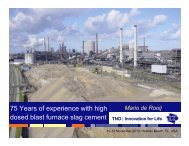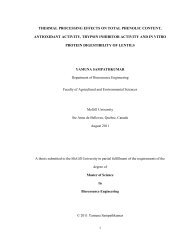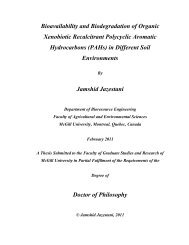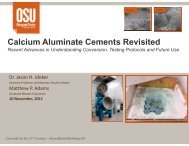foam-mat freeze drying of egg white and ... - McGill University
foam-mat freeze drying of egg white and ... - McGill University
foam-mat freeze drying of egg white and ... - McGill University
Create successful ePaper yourself
Turn your PDF publications into a flip-book with our unique Google optimized e-Paper software.
partial differential equations have very complex solutions but they can better explain the<br />
<strong>drying</strong> process (Liapis & Bruttini 1995; Barbosa-Canovas & Vega-Mercado 1996; Bala<br />
1997; Jafar & Farid 2003; Karel & Lund 2003).<br />
Earlier <strong>drying</strong> models were based on pure mass transfer <strong>and</strong> the effect <strong>of</strong> heat<br />
transfer was completely neglected. Mass transfer mechanism was assumed to be either by<br />
capillary or diffusion. But lot <strong>of</strong> research has been done in this area, with more<br />
parameters <strong>and</strong> conditions. Many <strong>mat</strong>he<strong>mat</strong>ical models have been proposed to describe<br />
<strong>drying</strong> (Karim & Hawlader 2005). Freeze <strong>drying</strong> involves simultaneous heat <strong>and</strong> mass<br />
transfer <strong>and</strong> this has to be taken into account when models are developed. However, the<br />
conditions governing heat <strong>and</strong> mass transfer are <strong>of</strong>ten simplified to model <strong>freeze</strong> <strong>drying</strong><br />
to determine <strong>drying</strong> rate <strong>and</strong> diffusion coefficient. Complex models are necessary to<br />
better describe <strong>drying</strong> kinetics during <strong>freeze</strong> <strong>drying</strong>. But it would be a better approach to<br />
start with simple models <strong>and</strong> improve the model to better describe the process (Karel<br />
1975; Flink & Knudsen 1983; P. Sheehan 1998).<br />
3.8.1 Heat Transfer<br />
In case <strong>of</strong> solid foods, heat transfer is usually modelled using Fourier’s<br />
conduction equation. Most <strong>of</strong> the models can be solved analytically but they are <strong>of</strong>ten<br />
very complex, hence numerical solutions are widely used for solving heat transfer models<br />
(Wang & Sun 2003). Some researchers analyzed radiation heat transfer method for <strong>freeze</strong><br />
<strong>drying</strong>. In this case, heat passes through the dry layer <strong>and</strong> is absorbed at subli<strong>mat</strong>ion<br />
interface. If radiation is a major source <strong>of</strong> heat supply, the <strong>freeze</strong> <strong>drying</strong> is heat transfer<br />
controlled <strong>and</strong> subli<strong>mat</strong>ion temperature becomes constant. Internal heat transfer<br />
resistance is much higher than mass transfer resistance. Quasi-steady state model is<br />
29









